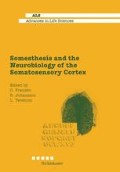Summary
This paper reviews recent research on haptic exploration of multidimensional objects. We consider the nature of manual exploration in terms of the prevailing characteristics of various “exploratory procedures” (“EPs”), that is, stereotypical hand movement patterns; we also explore the impact of these characteristics on the sequence in which EPs are selected during a constrained object identification task
Access this chapter
Tax calculation will be finalised at checkout
Purchases are for personal use only
Preview
Unable to display preview. Download preview PDF.
References
Klatzky, R.L. and Lederman, S.J. (1995) Identifying objects from a haptic glance.Perception and Psychophysics; in press
Klatzky, R.L., and Lederman, S J. (1993) Toward a computational model of constraint-driven exploration and haptic object identification.Perception22:597–621
Klatzky, R.L., Lederman, S.J., and Metzger, V. (1985) Identifying objects by touch: An “expert system”.Perception and Psychophysics37:299–302
Klatzky, R.L., Loomis, J., Lederman, S.J., Wake, H., and Fujita, N. (1993) Haptic identification of objects and their depictions.Perception & Psychophysics54:170–178
Lederman, S.J. (1991) Skin and touch. Encyclopedia of human biology, Vol. 7. Academic Press, San Diego, pp. 51–63
Lederman, S.J. and Klatzky, R.L. (1995) Early perceptual features for haptic object processing.Submitted for publication
Lederman, S.J. and Klatzky, R.L. (1990a) Flexible exploration by human and robotic haptic systems.Proceedings of the Annual International Conference of the IEEE/Engineering in Medicine and Biology Society12:1915–1916
Lederman, S.J., and Klatzky, R.L. (1990b) Haptic classification of common objects: Knowledge-driven exploration.Cognitive Psychology22:421–459
Lederman, S.J. and Klatzky, R.L. (1987) Hand movements: A window into haptic object recognition.Cognitive Psychology19:342–368
Loomis, JM. and Lederman, SJ. (1986) Tactual perception. In: K Boff, L Kaufman, and J Thomas (eds.), Handbook of perception and human performance., Wiley, New York, pp. 31-1–31-41
Rosch, E. (1978) Principles of categorization.In: E. Rosch and B. Lloyd (eds.),Cognition and categorization, Erlbaum, Hillsdale, N.J., pp. 27–8
Author information
Authors and Affiliations
Editor information
Editors and Affiliations
Rights and permissions
Copyright information
© 1996 Birkhäuser Verlag Basel/Switzerland
About this chapter
Cite this chapter
Lederman, S.J., Klatzky, R.L. (1996). Haptic object identification II: Purposive exploration. In: Franzén, O., Johansson, R., Terenius, L. (eds) Somesthesis and the Neurobiology of the Somatosensory Cortex. Advances in Life Sciences. Birkhäuser Basel. https://doi.org/10.1007/978-3-0348-9016-8_14
Download citation
DOI: https://doi.org/10.1007/978-3-0348-9016-8_14
Publisher Name: Birkhäuser Basel
Print ISBN: 978-3-0348-9868-3
Online ISBN: 978-3-0348-9016-8
eBook Packages: Springer Book Archive

